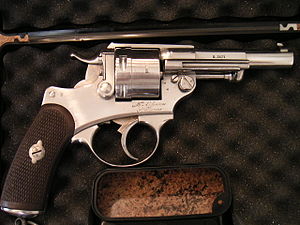- MAS 1873 revolver
-
French modèle 1873 revolver Type Service Revolver Place of origin  France
France
Service history In service 1873-1945 Used by France, Belgium, The Netherlands, Italy, Switzerland, Greece Wars French Colonial conflicts, First World War, Second World War Production history Designer Henri-Gustave Delvigne
J. ChamelotManufacturer Manufacture d'armes de Saint-Étienne Produced 1873-1887 Number built 337,000 Variants MAS 1874 Specifications Weight 1.04 kg Length 240 mm Barrel length 115 mm Cartridge 11 mm Mle 1873 Caliber 11 mm Action Double Action revolver Rate of fire 20–30 rounds/minute Effective range 50 metres Maximum range 300 metres Feed system 6-round cylinder Sights Fixed front blade and rear notch The service revolver model 1873 Chamelot-Delvigne was the first double action revolver used by the French army. It was produced by Manufacture d'armes de Saint-Étienne from 1873 to 1887 in about 337,000 copies. Although soon replaced by the Modele 1892 revolver, it was nevertheless widely used during the First World War, and issued to reserve units in 1940. The Resistance made widespread use of it during the Occupation.
The model 1874, of which 35,000 were made, was an officer version. It differs from model 1873 by a lighter structure and a darker finish. Many civilians copies were made in France and Belgium.
Both the 1873 and the 1874 use a 11mm cartridge which proved to have an insufficient velocity. The weapons themselves were very reliable and resistant.
A Navy version was also produced. A more powerful cartridge was produced for this version, but production ceased and they turned to the regular ammunition when the stocks were depleted.
Contents
Overview
The Franco-Prussian War in 1870 clearly demonstrated the need for up-to-date equipment in war time. A great military tradition and esprit de corps can be defeated by superior training, small arms, and in the case of that war, artillery. After the war, both Germany and France continued to improve their military technology. However, neither side was convinced of the importance of pistols for field officers. The sword continued to be the symbol of authority for an officer on the battlefield all the way into World War I. European general staffs at that time were extremely conservative and pistols were sometimes grudgingly adopted as personal defense weapons with no practical offensive use. Even as pistols became more of a symbol of the officer, most preferred to privately purchase a smaller and more comfortable handgun instead of using a large standard issue revolver.
The Chamelot-Delvigne 11mm Modele 1873 was adopted by the French army as a service revolver for non-commissioned officers. The Modele 1874 Revolver d'Officier was the version issued to officers. The differences between the two models included the following: the 1873 was finished in the white, whereas the 1874 had a fluted cylinder and a blued finish. The 1873 and 1874 were the first center-fire cartridge revolvers adopted by the French army. They had solid-frame, side-ejection, double-action mechanisms. The pistols were manufactured by the St. Etienne armoury, which still continues to manufacture fine sporting arms. The design of these pistols became so popular that versions were adopted by the Belgian, Dutch, Italian, and Swiss armies.
The caliber of these French pistols was 11x17.8mmR. The French round was actually 0.47 mm larger than its German counterpart. The German round could be loaded and used in the French pistol, but French rounds would not chamber in the German pistol. The cartridge had a pointed lead bullet weighing 11 grams. The case length was 17.8 mm, which was rather on the short side. Reloading this cartridge could take some patience due to the shortness of the case. Military specifications called for black powder loads, replaced by a mild smokeless powder in the early twentieth century. Standard muzzle velocity was around 550 feet per second.
The cylinder had a side-loading gate which pulled straight to the rear. The sight picture was a ball and v type and is easy to align. It could be difficult to stay on target double-action due to the stiffness of the action. There was certainly no danger of accidentally pulling the trigger double-action. Cleaning and disassembly were easy as the cylinder pin doubled as a screwdriver and all-purpose tool. Internal parts were finely machined and finished. The trigger, hammer, and several of the internal springs were straw-finished, a type of case-hardening hot oil finish.
The French pistols began their service with the French army in the late 19th Century and saw service all over the globe in French colonies. Many saw service in World War I when European armies finally realized how important pistols were in the trenches. The Chamelot-Delvigne finally ended its venerable service as a police sidearm in World War II.[1]
Features
Army model 73
- Length: 240 mm
- Barrel length: 115 mm
- Weight (empty): 1.04 kg
- Cylinder: 6 cartridges
- Ammunition: 11 mm Mle 1873 (11x17mmR)
- Rifling: 4 right
- Operation: single or double action.[2]
Army model 74
- Length: 228 mm
- Barrel length: 110 mm
- Weight (empty): 1 kg
- Cylinder: 6 cartridges
- Ammunition: 11 mm Mle 1873 (11x17mmR)
- Rifling: 4 right
- Operation: single or double action
Usage
Model 1873 was issued to the French Army, the French Navy, the National Gendarmerie and the National Police until 1962. It was also in use with Banque de France, the French Forces of the Interior and the National Forests Office.
The MAS 1873 served from the early days of the French Third Republic and the conquest of its empire, up to the Great War and the Second World War.
Bibliography
- Knowledge of the French service revolver model 1873, ebook by Gerard Henrotin - HLebooks.com 2011
References
External links
Categories:- Military revolvers
- Early revolvers
- French revolvers
- 1873 introductions
Wikimedia Foundation. 2010.

